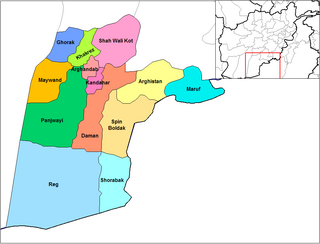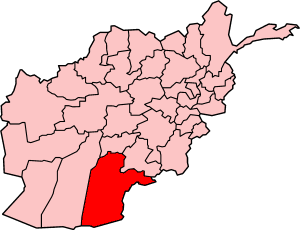
Panjwayi is a district in Kandahar Province, Afghanistan. It is located about 35 kilometres (22 mi) west of Kandahar. The district borders Helmand Province to the southwest, Maywand District to the west, Zhari District to the north, Arghandab, Kandahar and Daman districts to the east and Reg District to the south. Panjwayi was reduced in size in 2004 when Zhari District was created out of the northern part of it, on the northern side of the Arghandab River, which now forms the northern boundary.
Zhari is a district in Kandahar Province, Afghanistan. Alternative spellings include Zheley, Zharey, Zharay, Zheri, or Zheray. The district was created in 2004 from land that was formerly part of Maywand and Panjwai districts. The population is estimated at 80,700 (2010).
Operation Mountain Thrust was a joint NATO and Afghan-led military operation in the War in Afghanistan. It involved more than 3,300 British troops, 2,300 U.S. troops, 2,200 Canadian troops, along with approximately 3,500 Afghan soldiers, supported by extensive air power. Its primary objective was to quell the ongoing Taliban insurgency in the south of the country.

Operation Medusa was a Canadian-led offensive during the second Battle of Panjwaii of the War in Afghanistan. The operation was fought primarily by the 1st Battalion, The Royal Canadian Regiment Battle Group and other elements of the International Security Assistance Force, including A Co, 2-4 Infantry BN, 4th BDE, 10th Mtn Division, supported by the Afghan National Army and a team from the United States Army's 1st Battalion, 3rd Special Forces Group (Airborne) augmented by C Company, 2nd Battalion, 87th Infantry Regiment of the 10th Mountain Division. Its goal was to establish government control over an area of Kandahar Province centered in the district of Panjwayi some 30 kilometres (19 mi) west of Kandahar city. A tactical victory, it resulted in the deaths of 12 Canadian soldiers; five during the major combat operations, five in bombings, and two in a mortar/RPG attack during the reconstruction phase of the operation. Fourteen British military personnel were also killed when their plane crashed. Despite suffering a brutal battlefield defeat, the Taliban retained their presence in Kandahar province and did not lose their will to fight, leading to the subsequent Operation Falcon Summit. Nonetheless, Operation Medusa was at the time the most significant land battle ever undertaken by NATO.

Operation Mountain Fury was a NATO-led operation begun on September 16, 2006 as a follow-up operation to Operation Medusa, to clear Taliban insurgents from the eastern provinces of Afghanistan. Another focus of the operation was to enable reconstruction projects such as schools, health-care facilities, and courthouses to take place in the targeted provinces.

Musa Qala is a town and the district centre of Musa Qala District in Helmand Province, Afghanistan. It is located at 32.4433°N 64.7444°E and at an altitude of 1,043 m in the valley of Musa Qala River in the central western part of the district. Its population has been reported in the British press to be both 2,000 and 20,000. It is in a desolate area, populated by native Pashtun tribes.

The Helmand province campaign was a series of military operations conducted by the International Security Assistance Force (ISAF) forces against Taliban insurgents and other local groups in the Helmand Province of Afghanistan. Their objective was to control a province that was known to be a Taliban stronghold, and a center of opium production. None of the ISAF's intended strategic and political objectives were achieved in the long term.

US and NATO International Security Assistance Force (ISAF) operations, alongside Afghan National Army forces, continued against the Taliban through 2007.

The Battle of Arghandab began on June 18, 2008, when NATO-led forces attacked Taliban militants in response to Taliban attacks in Arghandab District and Kandahar. The battle in Arghandab marked the second time in less than a year that the Taliban has tried to take control of the area.
United States and NATO International Security Assistance Force (ISAF) operations, alongside Afghan National Army forces, continued against the Taliban through 2008.

Operation Shahi Tandar, also called Operation Atal, was a series of operations by Coalition troops from the British 42 Commando Royal Marines, Royal Canadian Regiment, 2nd Battalion 2nd Infantry Regiment, and the Afghan national military in central Helmand province and the Western Panjwayi and Western Zhari districts of Kandahar, Afghanistan from January 7–31, 2009.

The siege of Musa Qala took place between July 17 and September 12, 2006 in Afghanistan's Helmand province. A small force of International Security Assistance Force (ISAF) troops and Afghan security forces were besieged by Taliban insurgents inside the district centre of Musa Qala.

The 205th 'Atul' (Hero) Corps was a corps-level formation of the Afghan National Army. Its headquarter were located in Kandahar and it was responsible for the south of the country, partnered with the ISAF's Regional Command South.
Operation Moshtarak, also known as the Battle of Marjah, was an International Security Assistance Force (ISAF) pacification offensive in the town of Marjah, Helmand Province, Afghanistan. It involved a combined total of 15,000 Afghan, American, British, Canadian, Danish, and Estonian troops, constituting the largest joint operation of the War in Afghanistan up to that point. The purpose of the operation was to remove the Taliban from Marja, thus eliminating the last Taliban stronghold in central Helmand Province. The main target of the offensive was the town of Marjah, which had been controlled for years by the Taliban as well as drug traffickers.
Events from the year 2010 in Afghanistan.
Events from the year 2011 in Afghanistan.
Task Force Kandahar (TFK) was the formation conducting the International Security Assistance Force (ISAF) mission in Kandahar Province under ISAF Regional Command South. When it concluded its mission in summer 2011, the formation included a Canadian Forces battle group, three U.S. Army battalions, an engineer regiment, a signal squadron, Operational Mentor and Liaison Teams (OMLTs), and contributions to Operational Mentor and Advisory Teams (OMATs) and the Police Operational Mentor and Liaison Team (P-OMLT).
Khosrow Sofla was a village in the Arghandab District of Kandahar Province in southern Afghanistan that was demolished by the United States Army in October and November 2010. After experiencing high casualties resulting from firefights and improvised explosive devices (IEDs) outside the village, Lieutenant Colonel David S. Flynn of the American 1-320th field artillery, a part of the 101st Airborne Division, ordered villagers to evacuate Khosrow Sofla, Khosrow Ulya, Tarok Kolache, and Lower Babur and used aerial bombardment to partially or wholly destroy the villages.
Lower Babur is a village in the Arghandab District of Kandahar Province in southern Afghanistan that was destroyed by American military forces in October and November 2010.








